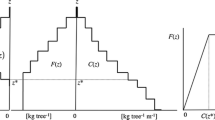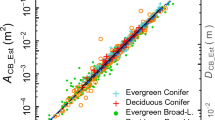Abstract
There is an exceptional case in which Shinozaki’s pipe model predictions should not explain that the allometric scaling exponent between foliage mass and stem diameter at the crown base is bigger than 2 empirically. This study proposes an allometric scaling model with components f and b, which are the scaling exponent between the sapwood area and stem cross-sectional area and foliage mass and the stem cross-sectional area at crown base, respectively. The scaling exponent f of sapwood area versus stem diameter at the crown base has no effect on leaf mass versus stem diameter at the crown base, while the scaling exponent b has effects on leaf mass versus stem diameter at the crown base. Because the value of b is greater than unity, this scaling model predicts that the diameters of conduits at the crown base widen with tree size, indicating tip–base widening of conduits. Because the proportion of sapwood area remains constant (or f = 0) across sizes, the assumption of Shinozaki’s pipe model theory appears to apply to the case f = 0.




Similar content being viewed by others
References
Adu-Bredu S, Hagihara A (1996) Sapwood amount and its predictive equations for young hinoki cypress (Chamaecyparis obtusa) trees. Bull Nagoya Univ For 15:11–21
Anfodillo T, Carraro V, Carrer M, Fior C, Rossi S (2006) Convergent tapering of xylem conduits in different woody species. New Phytol 169:279–290
Hagihara A, Yokota T, Ogawa K (1993) Allometric relations in hinoki (Chamaecyparis obtusa (Sieb. et Zucc.) Endl.) trees. Bull Nagoya Univ For 12:11–29
Kobayashi M, Maskawa T (1973) CP-violation in the renormalizable theory of weak interaction. Prog Theor Phys 49:652–657
Koçillari L, Olson ME, Suweis S et al (2021) The Widened pipe model of plant hydraulic evolution. PNAS 118:1–8
Lehnebach R, Beyer R, Letort V, Heuret P (2018) The pipe model theory half a century on: a review. Ann Bot 121:773–795
Longuetaud F, Monthe F, Leban J, Mäkelä A (2006) Picea abies sapwood width: variations within and between trees. Scand J for Res 21:41–53
Mäkelä A, Albrektson A (1992) An analysis of the relationship between foliage biomass and crown surface area in Pinus sylvestris in Sweden. Scand J For Res 7:297–307
Mäkelä A, Virtanen K, Nikinmaa E (1995) The effects of ring width, stem position, and stand density on the relationship between foliage biomass and sapwood area in Scots pine (Pinus sylvestris). Can J For Res 25:970–977
Meadows JS, Hodges JD (2002) Sapwood area as an estimator of leaf area and foliar weight in cherrybark oak and green ash. For Sci 48:69–76
Mencuccini M, Grace J (1995) Climate influences the leaf area/sapwood area ratio in scots pine. Tree Physiol 15:1–10
Monsi M, Saeki T (1953) Über den Lichtfaktor in den Pflanzengesellschaften und seine Bedeutung für die Stoffproduction. Jpn J Bot 14:22–52
Ogawa K (2015) Mathematical consideration of the pipe model theory in woody plant species. Trees 29:695–704
Olson ME, Anfodillo T, Rosell JA, Petit G, Crivellaro A, Isnard S, Lèon-Gòmez C, Alvarado-Càrdenas LO, Castorena M (2014) Univeral hydraulics of the flowering plants: vessel diameter scales with stem length across angiosperm lineages, habits and climates. Ecol Lett 17:988–997
Olson ME, Soriano D, Rosell JA et al (2018) Plant height and hydraulic vulnerability to drought and cold. PNAS 115:7551–7556
Olson ME, Anfodillo T, Gleason SM, McCulloh KA (2021) Tip-to-base xylem conduit widening as an adaptation: causes, consequences, and empirical priorities. New Phytol 229:1877–1893
Petit G, Anfodillo T (2009) Plant physiology in theory and practice: an analysis of the WBE model for vascular plants. J Theor Biol 259:1–4
R Core Team (2021) R: a language and environment for statistical computing. r foundation for statistical computing, Vienna, Austria
Ryan MG (1989) Sapwood volume for three subalpine conifers: predictive equations and ecological implications. Can J For Res 19:1379–1401
Savage VM, Bentley LP, Enquist BJ, Sperry JS, Smith DD, Reich PB, von Allmen EI (2010) Hydraulic trade-offs and space filling enable better predictions of vascular structure and function in plants. PNAS 107:22722–22727
Shelburne VB, Hedden RL, Allen RM (1993) The effects of site, stand density and sapwood permeability on the relationship between leaf area and sapwood area in loblolly pine (Pinus taeda L.). For Ecol Manag 58:193–209
Shinozaki K, Yoda K, Hozumi K, Kira T (1964a) A quantitative analysis of plant form – the pipe model theory. I Basic Anal Jpn J Ecol 14:97–105
Shinozaki K, Yoda K, Hozumi K, Kira T (1964b) A quantitative analysis of plant form: the pipe model theory. II. Further evidence of the theory and its application in forest ecology. Jpn J Ecol 14:133–139
Vanninen P, Ylitalo H, Sievänen R, Mäkelä A (1996) Effects of age and site quality on the distribution of biomass in Scots pine (Pinus sylvestris L.). Trees 10(4):231–238. https://doi.org/10.1007/BF02185674
Warton DI, Wright IJ, Falster DS, Westoby M (2006) Bivariate line fitting methods for allometry. Biol Rev 81:259–291
West GB, Brown JH, Enquist BJ (1999) A general model for the structure and allometry of plant vascular systems. Nature 400:664–667
Whitehead D, Edwards WRN, Jarvis PG (1984) Conducting sapwood area, foliage area, and permeability in mature trees of Picea sitchensis and Pinus contorta. Can J For Res 14:940–947
Acknowledgements
I thank the staff of the Nagoya Regional Forest Office and the Midorigaoka Nursery attached to the Gifu District Forest Office for providing the seedlings, and the staff of Nagoya University Forest for the use of their facilities. I also thank the reviewers, especially Matiss Castorena, University of Arizona, for their invaluable comments.
Author information
Authors and Affiliations
Contributions
The author (KO) designed research, collected the data, analyzed them, and wrote the paper.
Corresponding author
Ethics declarations
Conflict of interest
The author (KO) declares that he has no conflict of interest.
Additional information
Communicated by Hans Pretzsch.
Publisher's Note
Springer Nature remains neutral with regard to jurisdictional claims in published maps and institutional affiliations.
Rights and permissions
About this article
Cite this article
Ogawa, K. Allometric scaling of leaf mass based on the pipe model theory for woody plant species. Eur J Forest Res 141, 481–487 (2022). https://doi.org/10.1007/s10342-022-01455-7
Received:
Revised:
Accepted:
Published:
Issue Date:
DOI: https://doi.org/10.1007/s10342-022-01455-7




